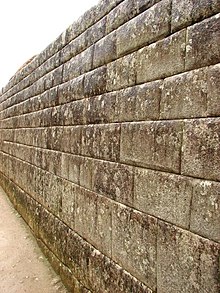
Back Kvádříkové zdivo Czech Kvadersten Danish Quader (Stein) German Kvadro (ŝtono) Esperanto Kvaader Estonian سنگ نما Persian Kváderkő Hungarian Quadro IO Concio (architettura) Italian 切石積み Japanese
This article may be confusing or unclear to readers. (February 2021) |




Ashlar (/ˈæʃlər/) is a cut and dressed stone, worked using a chisel to achieve a specific form, typically rectangular in shape. The term can also refer to a structure built from such stones.[1]
Ashlar is the finest stone masonry unit, and is generally rectangular (cuboid). It was described by Vitruvius as opus isodomum or trapezoidal. Precisely cut "on all faces adjacent to those of other stones", ashlar is capable of requiring only very thin joints between blocks, and the visible face of the stone may be quarry-faced or feature a variety of treatments: tooled, smoothly polished or rendered with another material for decorative effect.[2][3] One such decorative treatment consists of small grooves achieved by the application of a metal comb. Generally used only on softer stone ashlar, this decoration is known as "mason's drag".[4]
Ashlar is in contrast to rubble masonry, which employs irregularly shaped stones, sometimes minimally worked or selected for similar size, or both. Ashlar is related but distinct from other stone masonry that is finely dressed but not quadrilateral, such as curvilinear and polygonal masonry.[3][5]
Ashlar may be coursed, which involves lengthy horizontal layers of stone blocks laid in parallel, and therefore with continuous horizontal joints. Ashlar may also be random, which involves stone blocks laid with deliberately discontinuous courses and therefore discontinuous joints both vertically and horizontally. In either case, it generally uses a joining material such as mortar to bind the blocks together, although dry ashlar construction, metal ties, and other methods of assembly have been used. The dry ashlar of Inca architecture in Cusco and Machu Picchu is particularly fine and famous.
- ^ Reich, Ronny; Katzenstein, Hannah (1992). "Glossary of Archaeological Terms". In Kempinski, Aharon; Reich, Ronny (eds.). The Architecture of Ancient Israel. Jerusalem: Israel Exploration Society. p. 312. ISBN 978-965-221-013-5.
- ^ Cite error: The named reference
Ching et al 2007 p759was invoked but never defined (see the help page). - ^ a b Cite error: The named reference
Sharon 1987 p32-33was invoked but never defined (see the help page). - ^ Cite error: The named reference
Dundeewas invoked but never defined (see the help page). - ^ Cite error: The named reference
Wright GRH 2000 p100was invoked but never defined (see the help page).
© MMXXIII Rich X Search. We shall prevail. All rights reserved. Rich X Search